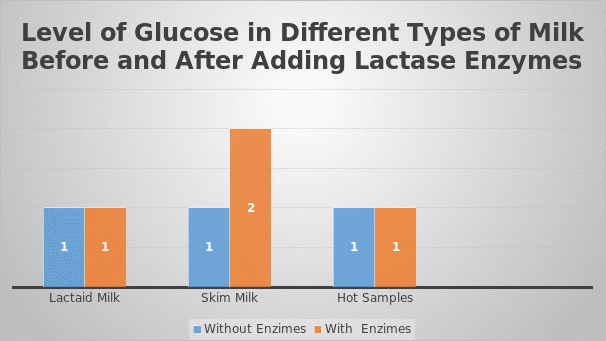Introduction
The problem of glucose intolerance is quite common these days. Lactose is a sugar, more precisely a disaccharide, consisting of two simple sugars, glucose and galactose (Del Rosario, 2020). When a person consumes dairy products, lactase enzymes, which is a type of protein, break down lactose into glucose and galactose in the intestines to absorb them (Del Rosario, 2020). However, people with intolerances do not have enough enzymes, which lactose to sit in the intestines. Consequently, a person with lactose intolerance cannot eat dairy products as this causes them to have gas, bloating, or diarrhea (Del Rosario, 2020). In this project, I will test the difference between regular milk and Lactaid milk in practice to test the thesis that enzymes break down lactose.
Problem and Hypothesis of the Research
The main problem or research question is the difference between regular milk and Lactaid milk. I explore this question by measuring glucose in different types of milk after adding lactase enzymes because they should only work for regular milk. Hence, the hypothesis of the study is if ordinary milk shows the presence of glucose, but Lactaid milk does not, after adding lactase enzymes, then the difference between these types of milk lies in the content of sugar that reacts to enzymes.
Process of the Experiment
I will need Lactaid milk, skim milk, lactase enzyme tablets, water, cups, glucose test strip, stirring rod, or stick for the experiment. One needs to complete the following steps to conduct the experiment.
- Dissolve one enzyme tablet in 200 ml of water to obtain an enzyme solution.
- Pour 20 ml of skim and Lactaid milk into separate cups.
- Check the glucose level in skim and Lactaid milk.
- Add 10 ml of enzyme solution to skim and Lactaid milk and stir.
- Check the glucose level in skim and Lactaid milk with added enzymes.
- Additionally, heat both types of milk and repeat the experiment to check the impact of temperature on enzymes.
Observations
The table summarizes observations during the experiment.
Table 1. Observations during the experiment.
This graph shows the level of glucose in Lactaid and skim milk before and after adding enzymes, as well as in heated samples. In this graph, “1” means “no glucose,” and “2” means “glucose is present”.

Analysis
The experiment demonstrates that the difference between regular and Lactaid milk is the presence of the sugar lactose, which reacts with the enzyme lactase and breaks down into two simple sugars. Evidence of this process is the appearance of glucose in milk, which the intestines must absorb. Sugar such as sucrose is included in Lactaid milk, but the enzyme lactase cannot break it down; therefore, glucose did not appear in the milk (Del Rosario, 2020). In addition, since there was no glucose in regular milk before the addition of the enzyme, this fact confirms that a lack of lactase causes lactose intolerance, due to which a person cannot consume dairy products. Symptoms of the condition include gas, bloating, cramping, and diarrhea.
Conclusion
Therefore, the data of the experiment confirm the hypothesis. The data show that the difference between regular milk and Lactaid milk is that regular milk contains the sugar lactose, which the intestines can only absorb after interacting with the enzyme lactase. This lab relates to my study because we studied the interaction of different chemicals in the human body theoretically for our classes. The experimental error could occur if the cups were poorly washed or the milk was hot. This experiment can be improved by using different proportions of enzymes and milk, as well as various temperatures of liquids. However, the current test was successful and confirmed the hypothesis.
Reference
Del Rosario, F.J. (2020). Lactose intolerance. Teens Health. Web.